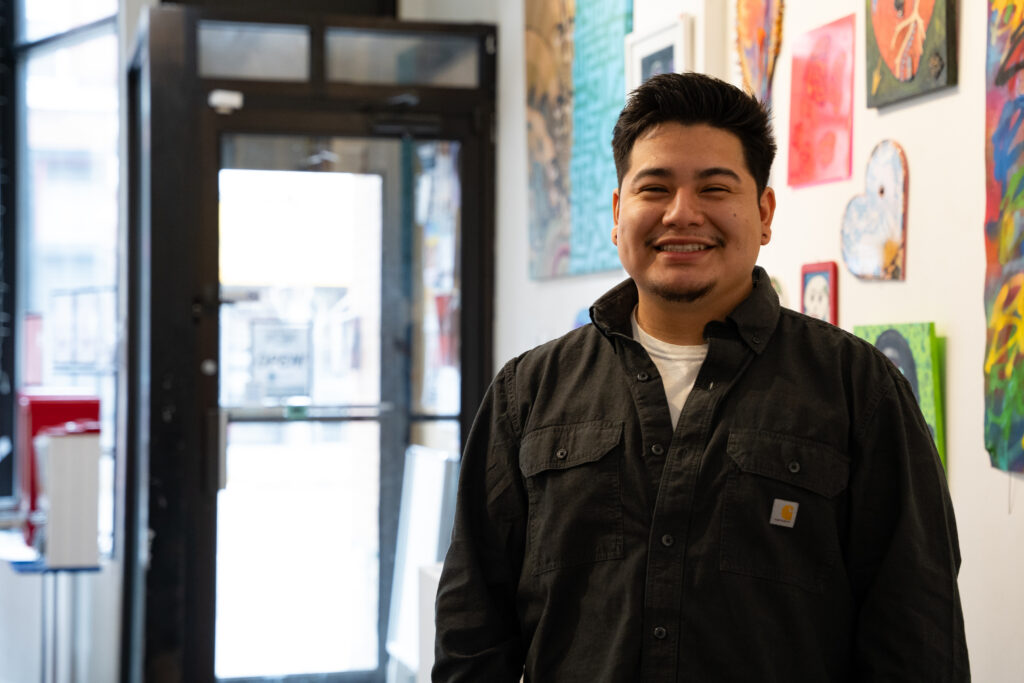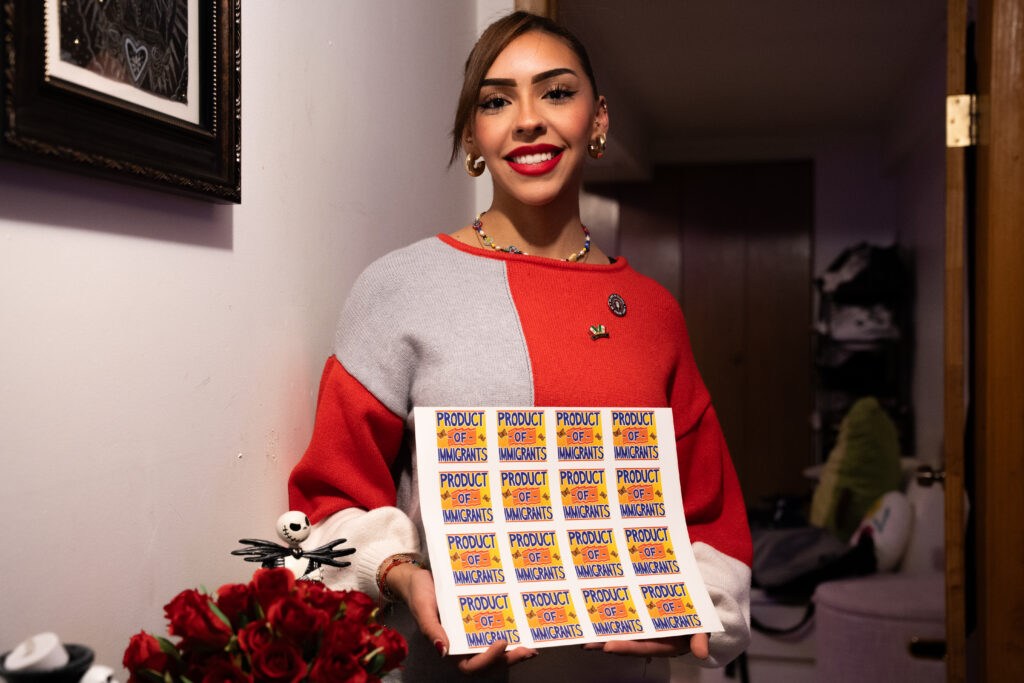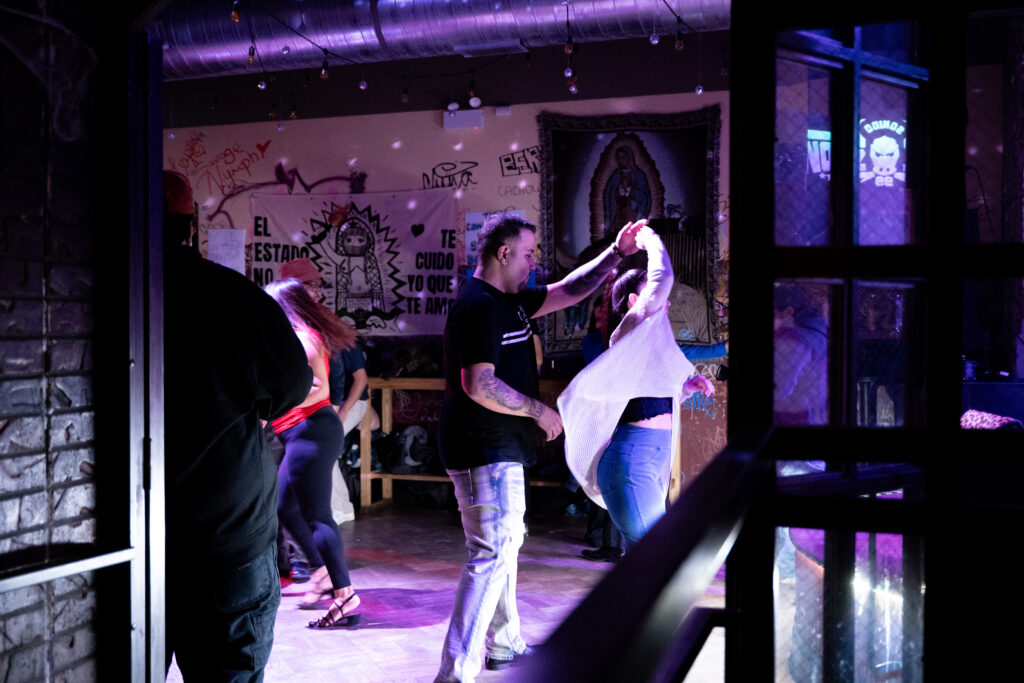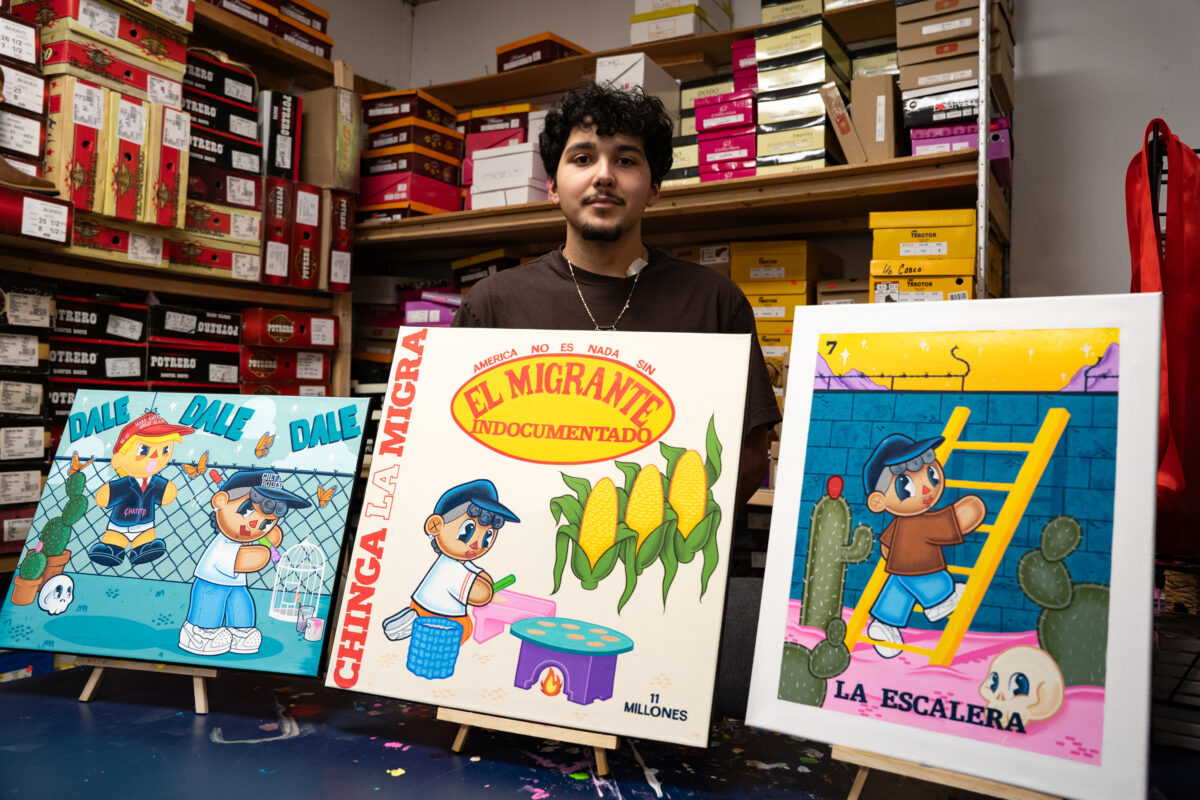On January 29, Saúl Cariño-Palma, a local sonidero, or traditional cumbia DJ, hosted Tributo a los Inmigrantes—a tribute to immigrants—at The Giant Penny Whistle bar in Pilsen.
Protest posters championing immigrant rights, made by community members at a January event organized by the Ruidosa Art Collective, hung on the walls. Behind an altar with a statue of La Virgen de Guadalupe surrounded by framed photographs of his parents, Cariño-Palma, a second-generation Mexican American, shared his family’s migration story during his set.
“We are not here to harm you,” Cariño-Palma said in Spanish. “We are not hatred like those who are attacking us.”
In his first hundred days in office, President Donald Trump has instilled fear in immigrant communities, he said. His administration has promised to execute the largest mass deportation program in U.S. history, and called Chicago “ground zero” for his anti-immigration efforts. In recent months, federal officers from Immigration and Customs Enforcement (ICE) and other agencies have made arrests in the Chicago area, sweeping up many who don’t have criminal records. The threats and activity have caused a disruption in immigrant communities and led to this year’s Cinco de Mayo parade in Little Village being cancelled out of fear of raids.
For Cariño-Palma, twenty-six, it is essential for artists—especially those with immigrant roots—to use their voices to expand the message.

Cariño-Palma remembers the childhood mornings when his mother flooded the house with cumbia classics: “La Cumbia Del Amor,” “El Diario De Un Borracho,” and “Mentirosa”. Following his mother’s lead while pretending to be the artist, Cariño-Palma would dance around the house. “Through cumbia, we unite,” Cariño-Palma said.
Years later, his love for music led him to become a sonidero. Each sonidero has a unique voice, he said. Some use phrases to be identified, others use pre-recorded sounds, and others, like Cariño-Palma, make audiences reflect through their life stories.
As the flavor of cumbia swept through the bar and the attendees danced, Cariño Palma lowered the speakers’ volume and readied his voice. His parents’ journey to the U.S. took over a month, he said. They faced many challenges and narrowly avoided a robbery along their journey. “Hold my hand,” Cariño-Palma said his mother told his father in the face of danger, as they quietly prayed La Magnifica, a Catholic prayer believed to be first recited by the Virgin Mary that is often used during Mexican religious events. The robbers didn’t see her or the migrants that traveled with them.
The day after they arrived in the United States, it was Cariño-Palma’s father’s birthday; they didn’t celebrate, as he had to go out and work. He needed to provide for his family, Cariño-Palma said.
“I wouldn’t be here playing these cumbias; I wouldn’t be here talking with you if my parents hadn’t made the decision to be in this country,” he said. “I think it’s important that these stories are told so they’re not forgotten, so we don’t forget the privilege we have because it is a privilege to be here.”
Cariño-Palma is part of a young generation of first and second-generation artists who use their work to advocate for change amidst the Trump administration’s actions and rhetoric against immigrants.
At Cariño-Palma’s event, an oil painting titled El Migrante Indocumentado by local artist Alexis Patiño was raffled; he donated it for the cause.
Patiño used tortilla packaging from El Milagro as inspiration for his piece because of its importance and recognizability among Latines. The popular local tortilla business has been around since the 1950s; its employees walked out in protest against ongoing poor working conditions in 2021 as the Weekly reported. In the painting, Chatito, the character Patiño portrays in most of his work, prepares tortillas. Above him, written in Spanish: America no es nada sin el migrante indocumentado. “America is nothing without the undocumented migrant.”
Patiño said he named the character Chatito after the nickname his mother gave him as a kid. “I’m not 100% sure, but from what I’ve heard, it means ‘flat face,’” he said. Chatito’s appearance is inspired by the MuñecasLelé. The handmade dolls are made by the Otomí—an Indigenous group from central Mexico, where Patiño’s family is from—and are dressed in their traditional clothing and long braids.
Patiño arrived in the United States with his parents when he was two years old. Although Spanish was always spoken at home, maintaining his language and culture outside his home country wasn’t easy.
For Patiño, art has always been a way to stay connected to the land from which he was uprooted. “Having these dolls that are from Mexico, seeing the culture brought over here to the United States, it’s something really nice,” he said. “By having Chatito here, it makes me feel like I still have a little bit of Mexico here with me.”
The Patiño family business, a convenience store in Aurora, sells a variety of Latin American clothing and goods. The Guatemalans, Mexicans, and Colombians who make up their customer base all come for a piece of home, Patiño said. Over the years, Patiño has transformed the backroom of the business into his studio space. Being close to that cultural hub gives him the opportunity to learn from other cultures. “Culture is something very beautiful. I just really like learning about it, embracing it, and celebrating it,” he said.
He’s noticed a decrease in customer flow following Trump’s election. “A lot of people have told us they’ve been afraid to go out—to leave their house to go to the store, to go to the park, to go to school,” he said. “I feel like a lot of people have been more comfortable being hateful towards immigrants—a lot of immigrants who have come to this country in search of a better life. We have so much to us, and so we’re not just working labor. We bring a lot, we bring culture.”
Patiño believes art that speaks about immigration is more important now than ever. “Tenemos que alzar nuestras voces”—“We have to raise our voices,” he said.
Earlier this year, Patiño remembers working with his aunt when he received a social media post of someone waving a reproduction of his El Milagro piece during a protest. “We have to let each other know that we are not alone, we are here together. We have each other.”
The journey to support his community led Patiño to hold giveaways of his artwork to promote the Midwest Immigration Bond Fund (MIBF) on social media. The nonprofit organization advocates for the abolition of immigration detention and surveillance and facilitates a fund to pay immigration bonds.
MIBF bonded nineteen people in 2024. Three and a half months into 2025, they’ve already bonded sixteen people, said Jesse Johnson, the organization’s co-vice president.
“It’s really given me hope to see this support, and to see the support from local people, and to see the support from first or maybe second-generation immigrants who are using their art in this time of uncertainty,” he said.
The MIBF experienced an increase in donations after Trump’s election as president, Johnson said. “People feel that this could really happen to anyone, and the fear that it’s going to get worse and worse.”
Patiño is not the only artist to have supported the MIBF. Gaby Pérez, a local Mexican American artist and educator, has been raising money for the organization through her sticker art. Earlier this year, she began a series of artworks advocating for immigrant rights.
“I entered almost like this frozen state where I don’t know what to do. I feel super helpless. And I slowly started to express that frustration through art,” she said.
The Product of Immigrants, Pérez’s first piece in a series of stickers honoring her Mexican heritage, rapidly gained popularity, a feat that had never occurred with any of her artwork before, she said. “Even if I was working out of my basement with my really small Instagram account, I was still making an impact,” she said.
Pérez cuts the stickers, writes the addresses by hand on each envelope, and mails them to her customers. She wants people to use her as an example. “They don’t need to have professional studios; they don’t need to have like 10,000 followers on Instagram,” she said. “They don’t need all of that to be able to make some kind of change.”

Johnson said that Pérez has raised thousands of dollars for their organization. “I don’t know if she realized how much she would be raising for the bond fund.”
Pérez also dedicated herself to making an impact on a new generation by teaching art to high school students. She said she was inspired by an elementary school teacher, Ms. Vasquez, who gave her an opportunity to create art after school in an underfunded program.
“The more we pour into our communities, the richer the culture becomes, the closer the people become, and the harder we are to take down,” she said.
As an art educator, Pérez discovered that art could be a tool for social change. She said that it provides students with an outlet to express themselves and a safe space where to escape.
She fears that that space might not be enough any longer. Not long after Trump’s inauguration, Pérez noticed that many of her Latine students were fearful of what might happen to them or their family members.
Both of Pérez’s parents immigrated to the United States from Mexico before she was born. Although they are now U.S. citizens, Pérez said that she can only imagine the fear she would feel if they were not.
As a U.S. citizen, Pérez says that she is protected in a way that undocumented immigrants aren’t. This allows her to use her voice in ways that don’t necessarily put her in danger.
Pérez, Patiño, and Cariño-Palma—product of immigrants—all said that in moments like this, it is necessary for children of immigrants to remember where they come from, and that the U.S. is not their only home.
“Whenever one of us is down, the whole village comes together and gathers around that person and supports them,” Pérez said.
“It’s because of immigration they’re here, so it’s important whether they’re directly affected or not. I just think it’s important to support, usar las voces.” Patiño said.
“I feel like many people from the younger generation haven’t been told this history—they don’t know how they got here,” Cariño-Palma said. “Let me remind them so they can see, and so we fight harder.”

Alonso Vidal is a bilingual multimedia journalist and writer from Lima, Peru, now based in Chicago.

